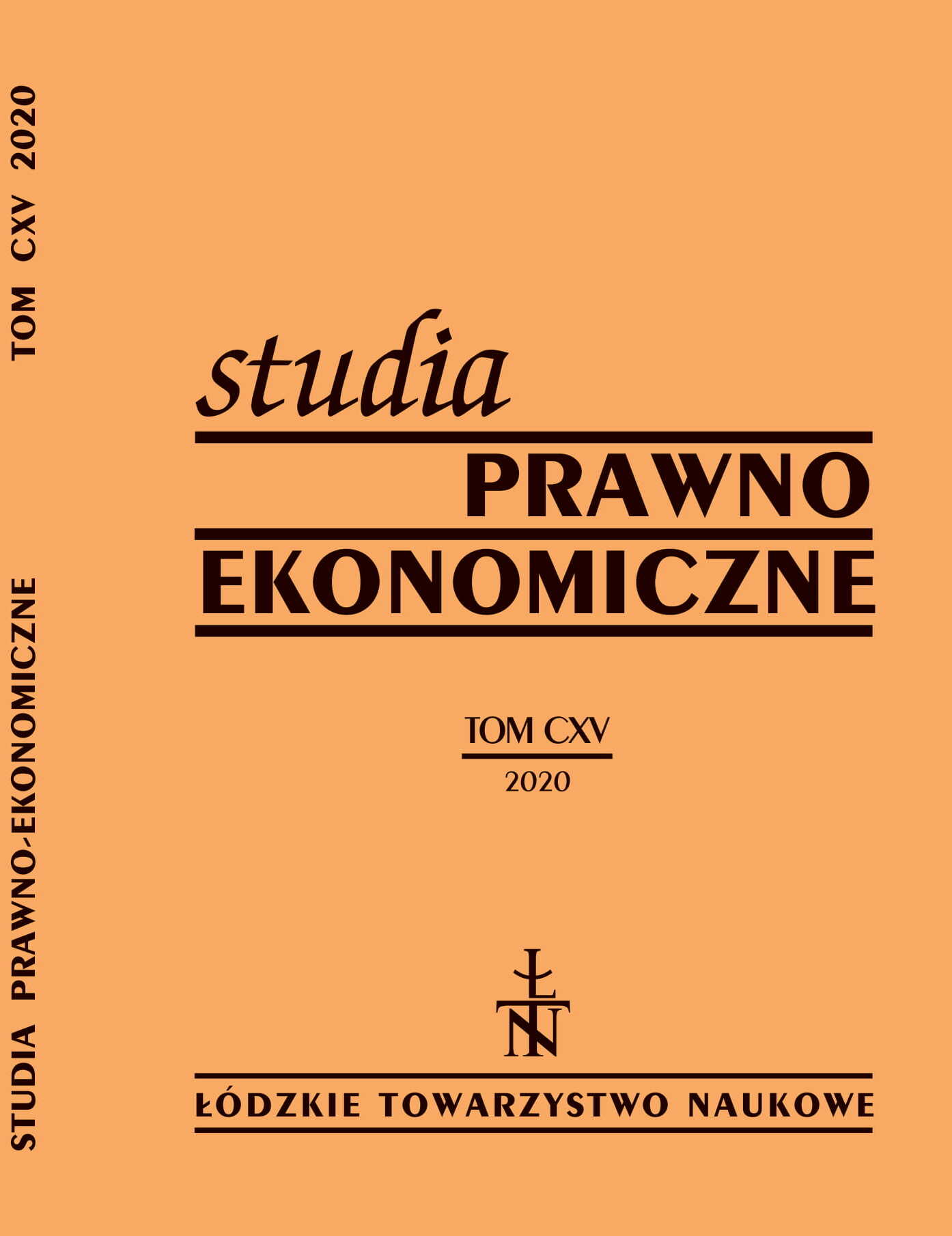Execution of movables according to the Italian Code of Civil Procedure – selected issues
DOI:
https://doi.org/10.26485/SPE/2020/115/4Keywords:
debtor, creditor, seizure of movables, the Italian lawAbstract
Background: The regulation of the Polish Code of Civil Procedure on the enforcement of movable property in enforcement proceedings, in force since 1.01.2019, is controversial in several aspects. This has inspired the comparative analysis of foreign language solutions.
In this study, Italian law was adopted as the subject of the study. The choice of this legal order was dictated by the existence of original institutions in the enforcement of movable property, in particular matters that were amended in Polish law from 1.01.2019.
Research purpose: The purpose of the study is to analyze the legal conditions in which the ex-ecution of movable property in Italian enforcement law is carried out. The subject of the author’s interest is to determine whether the solutions of Polish law fit into the model of execution on movable property in Italian law. The author inquired whether the Italian legislator regulated the issues of: the location of seizing activities, the catalog of movable property absolutely and relatively excluded from the seizure, the form and time of seizure of movables, and the sale of seized items.
Methods: Dogmatic and comparative law methods were used in the study.
Conclusions: As a result of analysing Italian enforcement law and the views expressed in the doctrine, it can be concluded that, in comparison with Italian law, Polish provisions on enforcement of movables are very strict and in practice they narrow the scope of their use. Attention should be paid to interesting – from the legal-dogmatical point of view and the enforcement practice – solutions of Italian enforcement of movable property. According to the research, the legislature introduced the possibility of, upon request by the creditor, the president of the court or a designated judge, permitting the bailiff to take custody of things that are marked as not belonging to the debtor but are subject to sale. In Italian law, unlike in Polish legislation, the period of validity for seizing movables was fixed, assuming that it loses its force after forty-five days, counting from its completion in the event of failure to sell things or counting their value towards debt.
A comparative legal analysis also leads to the conclusion that Polish provisions on the sale of movable property seized in the execution on property are very formalized. In Italian law, there are two main ways of monetizing things, i.e. commission and auction sales, and, importantly, commission sales take place completely outside of enforcement proceedings, as they are transferred to a third party for carrying them out. The commissioner sells things on his own behalf, for the account and commissioned by a public authority.
Downloads
References
Codice Civile, Regio Decreto 16 marzo 1942, n. 262, Gazzetta Ufficiale n. 79.
Codice di Procedura Civile, Regio Decreto 28 ottobre 1940, n. 1443, Gazzetta Ufficiale n. 253.
Legge 28 dicembre 2015, n. 221, Gazzetta Ufficiale 18 gennaio 2016, n. 13.
Ustawa z dnia 23 kwietnia 1964 r. Kodeks cywilny (tekst jedn. Dz.U. z 2019 r., poz. 1145 ze zm.).
Ustawa z dnia 17 listopada 1964 r. Kodeks postępowania cywilnego (tekst jedn. Dz.U. z 2019 r., poz. 1460 ze zm.).
Ustawa z dnia 22 marca 2018 r. o komornikach sądowych (Dz.U. z 2018 r., poz. 771).
Bonsignori A., Pignoramento, w: A. Azara, E. Eula (red.), Digesto Italiano. XIII, Torino 1966.
Bucolo F., Il processo esecutivo ordinario, CEDAM, Padova 1994.
Capponi B., Lineamenti del processo esecutivo, Bologna 2008.
Capponi B., Pignoramento, w: F.P. Casavola (red.), Enciclopedia Giuridica. Vol. XXIII, Roma 1990, s. 1–1116.
Castoro N., Castoro P., Il processo di esecuzione nel suo aspetto pratico, Milano 2017.
Cieślak S., w: J. Jankowski (red.), Kodeks postępowania cywilnego. Tom II. Komentarz. Art. 730–1217, C.H. Beck, Warszawa 2019, s. 1–1945.
Costantino G., Le espropriazioni forzate speciali. Lineamenti generali, Milano 1984.
Kostwiński M., Prawo obce w postępowaniu egzekucyjnym – zagadnienia wybrane, Przegląd Prawa Egzekucyjnego 2016/7, s. 31–57.
Kościółek A., Zmiany w przepisach o zajęciu ruchomości w egzekucji sądowej, w: A. Marciniak (red. nauk.), Analiza i ocena ustawy o komornikach sądowych oraz ustawy o kosztach komorniczych, Currenda, Sopot 2018, s. 607– 626.
Krakowiak M., Czynność zajęcia w egzekucji świadczeń pieniężnych w świetle prawa włoskiego – zagadnienia wybrane, w: A. Barańska, S. Cieślak (red. nauk.), Ars in vita. Ars in iure. Księga jubileuszowa dedykowana Profesorowi Januszowi Jankowskiemu, C.H. Beck, Warszawa 2018, s. 427–437.
Krakowiak M., Kluczowe zagadnienia egzekucji z ruchomości w sądowym postępowaniu egzekucyjnym po 1.01.2019 r., Monitor Prawniczy 2019/18, s. 992–1000.
Krakowiak M., Wyjawienie majątku dłużnika w postępowaniu egzekucyjnym w prawie hiszpańskim, włoskim i niemieckim, Studia Prawno-Ekonomiczne 2016/XCVIII, s. 71–88.
Luiso F.P., Diritto processuale civile. Volume III – Il processo esecutivo, Giuffrè Editore, Milano 2011.
Mancuso C., La ricerca delle cose da pignorare, w: F. De Santis, A. Didone (red.), Codice commentato delle esecuzioni civili, G. Arieta, UTET Giuridica, Vicenza 2017, s. 772–791, s. 835–840.
Muliński M., Zasada nieobciążania ponad potrzebę strony biernej postępowania zabezpieczającego i egzekucyjnego, Currenda, Sopot 2017.
Rocco U., Trattato di diritto processuale civile. IV. Parte Speciale. Processo esecutivo, Torino 1966
Schettini I., Processo di esecuzione. Parte I, Roma 1962.
Soldi A.M., Manuale dell’esecuzione forzata, CEDAM, Vicenza 2016.
Verde G., Pignoramento mobiliare diretto e immobiliare, w: Enciclopedia Diritto, t. XXXIII, Milano 1983, s. 1–1030.







